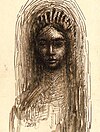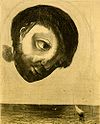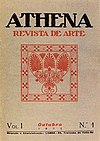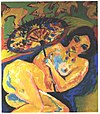Muzică minimalistă
| Muzica minimalistă | |
| Origini stilistice | Muzică experimentală Dodecafonism Muzică serială process music |
|---|---|
| Origini culturale | Statele Unite ale Americii |
| Instrumente tipice | Pian Orchestră Instrumente de percuție instrumente muzicale electronice echipament electronice de postproducție |
| Popularitate | Scăzută |
| Forme derivate | Postminimalism, totalism |
| Subgenuri | |
| Drone music (lista completă) | |
| Modifică text |
|
Muzica minimalistă este un stil de muzică asociat cu activitatea compozitorilor americani La Monte Young, Terry Riley, Steve Reich și Philip Glass.[1][2][3][4] Acesta îșî are originea în scena New York Downtown din anii 1960 și a fost inițial văzut ca o formă de muzică experimentală numit Școala Hipnotică din New York,[5] Principalele caracteristici ale stilului includ armonie consonant, puls constant (dacă nu drone-uri imobili), stagnare sau transformare treptată, și, adesea, reiterarea frazelor muzicale. sau unităților mai mici, cum ar fi figuri motive, și celule. Aceasta poate include caracteristici, cum ar fi procesul de aditivului și a fazei de schimbare, care duce la ceea ce a fost numit muzica fază. Compoziții minim care se bazeaza foarte mult pe tehnici de proces care urmează reguli stricte, de obicei, sunt descrise cu ajutorul muzicii procesul pe termenului.
Cuvântul "minimalism", făcut cunoscut independent unul de altul de către compozitorii Michael Nyman și Tom Johnson, este controversat, dar este des folosit încă de la mijlocul anilor 1970. Aplicarea unui termen din artele vizuale la muzică a fost contestat; totuși, nu numai că muzica de acest fel are aceeași simplicitate și aversiune pentru ornamentări excesive pe care o are și sculptura minimalistă, dar unele dintre primele concerte de muzică minimalistă au avut loc tocmai cu ocazia unor expoziții de arte vizuale minimaliste, de exemplu ale lui Sol LeWitt. Mai mulți compozitori asociați cu muzica minimalistă au criticat termenul, un exemplu notabil fiind Philip Glass.[6]
O formă mai recentă de muzică minimalistă este techno-ul minimalist, un subgen al muzicii techno. În formele ei cele mai simple, această muzică constă doar dintr-un singur motiv ostinato (deseori numit "loop muzical") cântat cu toba bas bătând pe pulsul de sfert de notă. În alte exemple, structuri ritmice de bază sunt puse unele peste altele creând astfel un acompaniament poliritmic pentru același puls de tobă bas de 4/4. Sherburne (2004) numește această tehnică masificare iar pe prima scheletalism.[7]
Compozitori minimaliști
[modificare | modificare sursă]Compozitori notabili
[modificare | modificare sursă]- John Adams
- Louis Andriessen
- David Behrman
- Barbara Benary
- David Borden
- Gavin Bryars
- Joseph Byrd
- Tony Conrad
- Tibor Szemző
- Julius Eastman
- Ludovico Einaudi
- Brian Eno
- Frans Geysen
- Jon Gibson
- Philip Glass
- John Godfrey (compozitor)
- Karel Goeyvaerts
- Michael Harrison
- Christopher Hobbs
- Terry Jennings
- Scott Johnson
- Douglas Leedy
- Angus MacLise
- Richard Maxfield
- Robert Moran
- Phill Niblock
- Michael Nyman
- Pauline Oliveros
- Charlemagne Palestine
- Rabinovitch-Barakovsky
- Michael James Regan
- Steve Reich
- Terry Riley
- Arthur Russell
- Howard Skempton
- Dave Smith
- Ann Southam
- Yoshi Wada
- John White
- La Monte Young
Compozitori contemporani
[modificare | modificare sursă]- Australia
- Andrew Chubb
- Robert Davidson
- Nigel Westlake
- Belgia
- Wim Mertens
- Canada
- Peter Hannan
- Kyle Bobby Dunn
- Estonia
- Finlanda
- Petri Kuljuntausta
- Erkki Salmenhaara
- Franța
- Germania
- Peter Michael Hamel
- Hauke Harder
- Hans Otte
- Ernstalbrecht Stiebler
- Walter Zimmermann
- Ungaria
- Zoltán Jeney
- László Melis
- László Sáry
- László Vidovszky
- Irlanda
- Michael James Regan
- Italia
- Fulvio Caldini
- Roberto Carnevale
- Lucio Garau
- Giovanni Sollima
- Ludovico Einaudi
- Japonia
- Jo Kondo
- Yoshi Wada
- Yasunori Mitsuda
- Latvia
- Armands Strazds
- Olanda
- Simeon ten Holt
- Polonia
- Zygmunt Krauze
- Tomasz Sikorski
- Rusia
- Vladimir Martynov
- Anton Batagov
- Serbia
- Vladimir Tošić
- Marea Britanie
- Joe Cutler
- Graham Fitkin
- Orlando Gough
- Steve Martland
- Andrew Poppy
- Simon Rackham
- Statele Unite
- John Luther Adams
- Glenn Branca
- Harold Budd
- Lawrence Chandler
- Richard Chartier
- Rhys Chatham
- Philip Corner
- Kurt Doles
- Arnold Dreyblatt
- Daniel Goode
- Rafael Anton Irisarri
- Tom Johnson
- Ingram Marshall
- Meredith Monk
- Tim Risher
- Frederic Rzewski
- Wayne Siegel
- Stars of the Lid (Adam Wiltzie & Brian McBride)
Minimaliști mistici
[modificare | modificare sursă]- Henryk Górecki
- Alan Hovhaness
- Giya Kancheli
- Hans Otte
- Arvo Pärt
- John Tavener
- Pēteris Vasks
Vezi și
[modificare | modificare sursă]- Post-minimalism
- Muzică process
- Muzică repetitivă
- Muzică drone
Referințe
[modificare | modificare sursă]- ^ Mertens, W. (1983), American Minimal Music, Kahn & Averill, London, (p.11).
- ^ Michael Nyman, writing in the preface of Mertens' book refers to the style as "so called minimal music" (Mertens 1983, p.8).
- ^ "The term 'minimal music' is generally used to describe a style of music that developed in America in the late 1960s and 1970s; and that was initially connected with the composers La Monte Young, Terry Riley, Steve Reich, and Philip Glass." Sitsky, L. (2002),Music of the twentieth-century avant-garde: a biocritical sourcebook,Greenwood Press, Westport, CT. (p.361)
- ^ Young, La Monte, "Notes on The Theatre of Eternal Music and The Tortoise, His Dreams and Journeys" (original PDF file), 2000, Mela Foundation, www.melafoundation.org — Historical account and musical essay where Young explains why he considers himself the originator of the style vs. Tony Conrad and John Cale.
- ^ Kostelanetz and Flemming 1997, 114–16.
- ^ [https://web.archive.org/web/20070331124515/http://www.philipglass.com/html/recordings/music-in-12-parts.html „PhilipGlass.com � Music in Twelve Parts”]. Arhivat din original la . Accesat în . replacement character în
|titlu=la poziția 17 (ajutor) - ^ Cox C. & Warner D. ed.(2004), Audio Culture: Readings in Modern Music, Continuum International Publishing Group Ltd, London.
Surse
[modificare | modificare sursă]- Bernard, Jonathan W. 1993. "The Minimalist Aesthetic in the Plastic Arts and in Music". Perspectives of New Music 31, no. 1 (Winter): 86–132.
- Bernard, Jonathan W. 2003. "Minimalism, Postminimalism, and the Resurgence of Tonality in Recent American Music". American Music21, no. 1 (Spring): 112–33.
- Cope, David. 1997. Techniques of the Contemporary Composer. New York, New York: Schirmer Books. ISBN 0-02-864737-8.
- Fink, Robert. 2005. Repeating Ourselves: American Minimal Music as Cultural Practice. Berkeley: University of California Press. ISBN 0-520-24036-7 (cloth). ISBN 0-520-24550-4 (pbk).
- Gann, Kyle. 1997. American Music in the Twentieth Century. Schirmer. ISBN 0-02-864655-X.
- Gann, Kyle. 1987. "Let X = X: Minimalism vs. Serialism." Village Voice (24 February): 76.
- Gann, Kyle. 2001. "Minimal Music, Maximal Impact: Minimalism's Immediate Legacy: Postminimalism". New Music Box: The Web Magazine from the American Music Center (November 1) (Accessed 4 February 2012).
- Gann, Kyle. 2006. Music Downtown: Writings from the Village Voice. Berkeley: University of California Press. ISBN 0-520-22982-7.
- Garland, Peter, and La Monte Young. 2001. "Jennings, Terry". The New Grove Dictionary of Music and Musicians, edited by Stanley Sadie and John Tyrrell. London: Macmillan.
- Gotte, Ulli. 2000. Minimal Music: Geschichte, Asthetik, Umfeld. Taschenbucher zur Musikwissenschaft, 138. Wilhelmshaven: Noetzel.ISBN 3-7959-0777-2.
- Johnson, Timothy A. 1994. "Minimalism: Aesthetic, Style, or Technique? " Musical Quarterly 78, no. 4 (Winter): 742–73.
- Johnson, Tom. 1989. The Voice of New Music: New York City 1972-1982 – A Collection of Articles Originally Published by theVillage Voice. Eindhoven, Netherlands: Het Apollohuis. ISBN 90-71638-09-X.
- Kostelanetz, Richard, and R. Flemming. 1997. Writings on Glass: Essays, Interviews, Criticism. Berkeley and Los Angeles: University of California Press; New York: Schirmer Books.
- Linke, Ulrich. 1997. Minimal Music: Dimensionen eines Begriffs. Folkwang-Texte Bd. 13. Essen: Die blaue Eule. ISBN 3-89206-811-9.
- Lovisa, Fabian R. 1996. Minimal-music: Entwicklung, Komponisten, Werke. Darmstadt: Wissenschaftliche Buchgesellschaft.
- MacDonald, Ian. 2003. "The People's Music". London: Pimlico Publishing. ISBN 1-84413-093-2.
- Mertens, Wim. 1983. American Minimal Music: La Monte Young, Terry Riley, Steve Reich, Philip Glass. Translated by J. Hautekiet; preface by Michael Nyman. London: Kahn & Averill; New York: Alexander Broude. ISBN 0-900707-76-3
- Meyer, Leonard B. 1994. Music, the Arts, and Ideas: Patterns and Predictions in Twentieth-Century Culture, second edition. Chicago and London: University of Chicago Press. ISBN 0-226-52143-5
- Nyman, Michael. 1968. "Minimal Music". The Spectator 221, no. 7320 (11 October): 518–19.
- Nyman, Michael. 1974. Experimental Music: Cage and Beyond. London: Studio Vista ISBN 0-289-70182-1; reprinted 1999,Cambridge: Cambridge University Press. ISBN 0-521-65383-5.
- Perlein, Gilbert, and Bruno Corà (eds). 2000. Yves Klein: Long Live the Immaterial! Catalog of an exhibition held at the Musée d'art moderne et d'art contemporain, Nice, April 28 – 4 septembrie 2000, and the Museo Pecci, Prato, 23 septembrie 2000 – 10 ianuarie 2001. New York: Delano Greenidge Editions, 2000, ISBN 978-0-929445-08-3.
- Potter, Keith. 2000. Four Musical Minimalists: La Monte Young, Terry Riley, Steve Reich, Philip Glass. Music in the Twentieth Century series. Cambridge and New York: Cambridge University Press. ISBN 0-521-48250-X.
- Potter, Keith. 2001. "Minimalism". The New Grove Dictionary of Music and Musicians, second edition, edited by Stanley Sadie and John Tyrrell. London: Macmillan Publishers; New York: Grove's Dictionaries of Music.
- Rose, Barbara. 1965. "ABC Art". Art in America 53, no. 5 (October–November): 57–69.
- Schönberger, Elmer. 2001. "Andriessen: (4) Louis Andriessen". The New Grove Dictionary of Music and Musicians, second edition, edited by Stanley Sadie and John Tyrrell. London: Macmillan Publishers; New York: Grove's Dictionaries of Music.
- Schwarz, K. Robert. 1996. Minimalists. 20th Century Composers Series. London: Phaidon. ISBN 0-7148-3381-9.
- Strickland, Edward. 1993. Minimalism: Origins. Bloomington: Indiana University Press. ISBN 0-253-35499-4 (cloth); ISBN 0-253-21388-6(pbk, corrected and somewhat revised printing, 2000). Chapter T, pp. 241–56, reprinted as Strickland 1997.
- Strickland, Edward. 1997. "Minimalism: T (1992)". In Writings on Glass: Essays, Interviews, Criticism, edited by Richard Kostelanetz and Robert Flemming, 113–130. Berkeley and Los Angeles: University of California Press; New York: Schirmer Books. ISBN 0-520-21491-9. Reprint of a chapter from Strickland 1993.
- Sweeney-Turner, Steve. 1995. "Weariness and Slackening in the Miserably Proliferating Field of Posts." Musical Times 136, no. 1833 (November): 599–601.
- Warburton, Dan. 1988. "A Working Terminology for Minimal Music." Intégral 2: 135–59.
Legături externe
[modificare | modificare sursă]- Art of the States: minimalist lucrări minimaliste ale compozitorilor Americani, incluzînd sample-uri audio.
- Art and Music Since 1945: Introduction to Minimal Music Arhivat în , la Wayback Machine., din Ohio State University, Departmentul Art Education.
- Minimal Music, Maximal Impact Arhivat în , la Wayback Machine., de Kyle Gann, cu o listă mai cuprinzătoare a artiștilor minimaliști timpurii.
| Artiști plastici minimaliști |
-----------------------------------------------------------------------------------------------------
| |
|---|---|---|
| Minimaliști în film |
-----------------------------------------------------------------------------------------------------
| |
| Muzicieni minimaliști |
-----------------------------------------------------------------------------------------------------
| |
| Scriitori minimaliști |
-----------------------------------------------------------------------------------------------------
| |
| Românii și minimalismul |
-----------------------------------------------------------------------------------------------------
| |
| Varii minimaliști |
-----------------------------------------------------------------------------------------------------
| |
| Articole conexe |
-----------------------------------------------------------------------------------------------------
| |
Modernism (f) ← Modernism (circa 1865-1960) → Postmodernism → Postmodernism (f) → Postmodernitate → → Post-Postmodernism | ||
|---|---|---|
| Grupuri / Expoziții • pre-moderniste • și moderniste • |
---------------------------------------------------------------------------------------------------------------------------
| |
| Axa timpului • Precursori • |
• Tristan Corbière • Charles Darwin • Feodor Dostoievski • Immanuel Kant • John Keats • Søren Kierkegaard • Nazarenism (von Cornelius – von Führich – Overbeck – von Schadow – J. Veit) • Prerafaeliții (Burne-Jones – Hunt – Millais – Morris – D. G. Rossetti) • Georges Seurat • August Strindberg • Alfred Tennyson • J. M. W. Turner • Walt Whitman ---------------------------------------------------------------------------------------------------------------------------
| |
| Artiști vizuali • fotografi • și arhitecți • |
---------------------------------------------------------------------------------------------------------------------------
| |
| Critici literari • |
---------------------------------------------------------------------------------------------------------------------------
| |
| Compozitori • și muzicieni • | ---------------------------------------------------------------------------------------------------------------------------
| |
| Reprezentanți literari • |
---------------------------------------------------------------------------------------------------------------------------
| |
| Tehnici literare • și ne-literare • |
---------------------------------------------------------------------------------------------------------------------------
| |
| Românii și modernismul • |
---------------------------------------------------------------------------------------------------------------
| |
| Moderni și post-moderni din România • (pro și contra) • | • Grupul onirist (a se vedea Onirism (f))
• Generația 1960 (neo-moderniști sau tardo-moderniști)
• Școala de la Târgoviște (prozatori) • Cenacluri literare, conducători de cenacluri și scriitori
--------------------------------------------------------------------------------------------------------------------------- | |
| Mișcări artistice distincte în modernism |
---------------------------------------------------------------------------------------------------------------------------
| |
| Articole conexe |
---------------------------------------------------------------------------------------------------------------------------
| |
Avangarda artistică românească • Grupări artistice • Secolul 20 în România • • Modernism • Listă de moderniști • • Minimalism • Postmodernism • Post-Postmodernism • Structuralism | ||
Modernism (f) — Modernism ← Postmodernism — Postmodernism (f) — Postmodernitate → Post-Postmodernism — Post-Postmodernism (f) | ||
|---|---|---|
| Precursori • |
-------------------------------------------------------------------------------------------------------------------------------
| |
| Artiști plastici • |
-------------------------------------------------------------------------------------------------------------------------------
| |
| Diferiți • reprezentanți • |
-------------------------------------------------------------------------------------------------------------------------------
| |
| Critică literară • Critici literari • |
| |
| Domenii • |
-------------------------------------------------------------------------------------------------------------------------------
| |
| Filozofi • postmoderniști • | ||
| Românii și • postmodernismul • |
--------------------------------------------------------------------------------------------------------------------------------
| |
| Poeți optzeciști • |
--------------------------------------------------------------------------------------------------------------------------------
| |
| Prozatori optzeciști • |
-------------------------------------------------------------------------------------------------------------------------------
| |
| Critici literari • (optzeciști români) | -------------------------------------------------------------------------------------------------------------------------------
| |
| Alte voci • (optzeciste române) |
-------------------------------------------------------------------------------------------------------------------------------
| |
| Subiecte conexe • • |
-------------------------------------------------------------------------------------------------------------------------------
| |
Listă de postmoderniști • • Avangarda artistică românească • Grupări artistice • Secolul 20 în România • Modernism • Minimalism • Postmodernism • Structuralism • Poststructuralism • | ||
Format:Structuralism
Text is available under the CC BY-SA 4.0 license; additional terms may apply.
Images, videos and audio are available under their respective licenses.





































